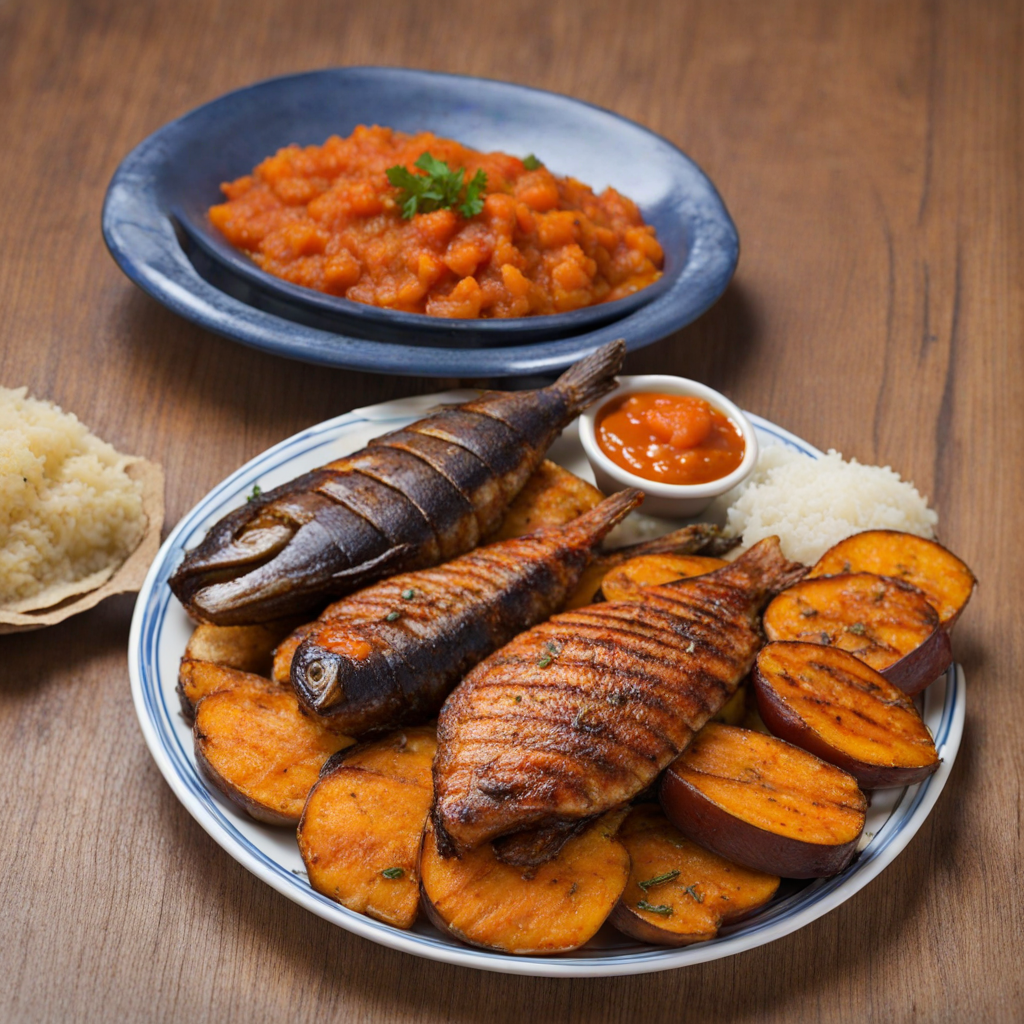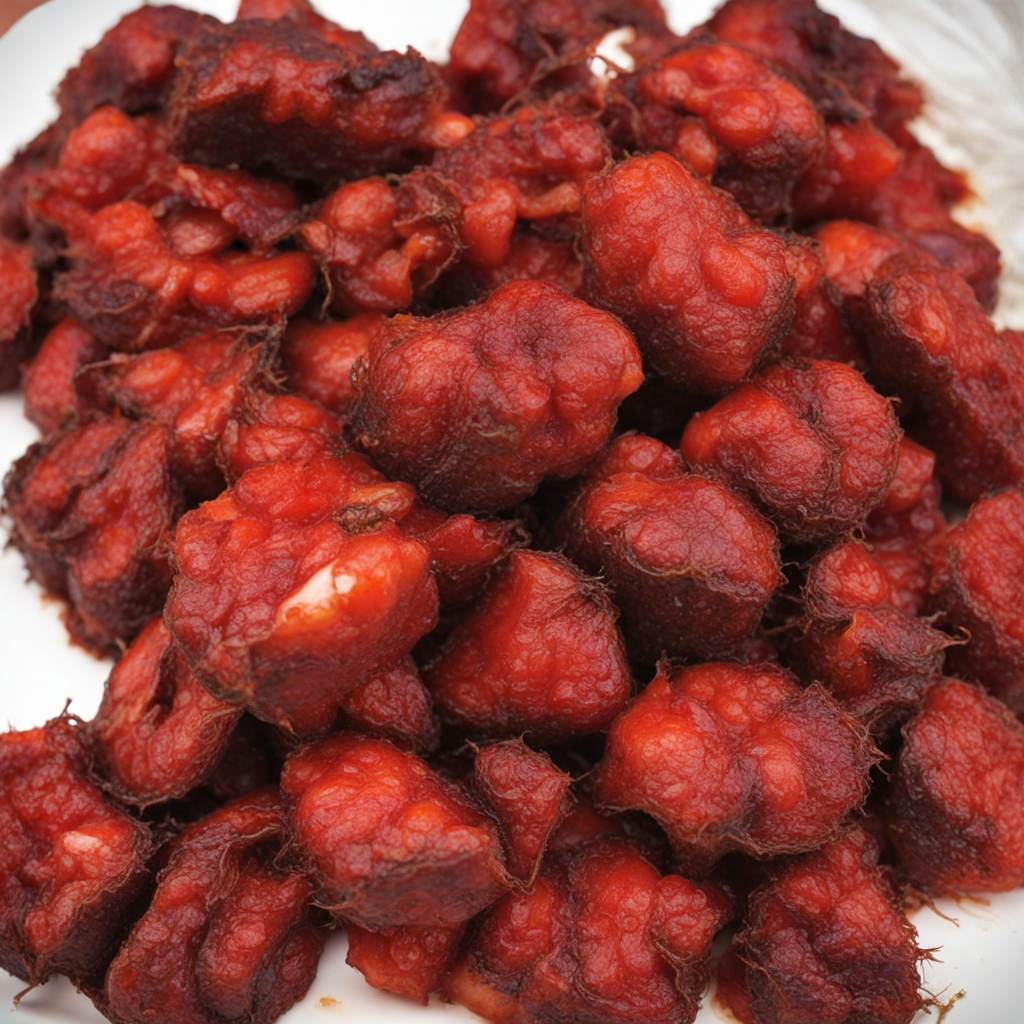Mufete
Mufete is a traditional Angolan dish that showcases the rich culinary heritage of the country, particularly along the coastal regions. This delightful meal typically features grilled fish, often accompanied by an array of vibrant sides that highlight the flavors of the region. The fish is marinated in a blend of spices and herbs, which may include garlic, lemon juice, and piri-piri sauce, adding a zesty kick to the dish. The grilling process imparts a smoky flavor, enhancing the overall taste experience and making each bite a celebration of freshness from the sea. In addition to the perfectly grilled fish, Mufete is usually served with a variety of side dishes that complement the main ingredient. One of the most popular accompaniments is a generous helping of cassava, which may be boiled or fried to provide a satisfying contrast to the fish. The dish is often garnished with a refreshing salad of tomatoes, onions, and peppers, drizzled with a light vinaigrette that adds a burst of acidity and freshness. These sides create a harmonious balance, allowing diners to savor the different textures and flavors in each mouthful. What truly sets Mufete apart is its communal nature; it’s often enjoyed in a social setting, bringing families and friends together around a table. The vibrant colors and aromas of the dish evoke the lively spirit of Angolan culture, making it not just a meal but an experience to cherish. Whether enjoyed at a local eatery or prepared at home, Mufete is a delightful exploration of Angolan cuisine that invites food lovers to indulge in its unique and delectable flavors.
How It Became This Dish
Mufete: A Culinary Journey Through Angola Mufete, a beloved dish from Angola, encapsulates the rich tapestry of the country's culture, history, and culinary traditions. This vibrant dish, often associated with the coastal regions, has its origins deeply rooted in the fishing communities of Angola, where the abundance of the Atlantic Ocean has shaped not only the diet but the very way of life for the people. #### Origins and Ingredients The name "Mufete" derives from the Kikongo word "mufetê," which translates to "to grill" or "to roast." Traditionally, Mufete consists of grilled fish, often accompanied by a plethora of sides that may include cassava, sweet potatoes, plantains, and a spicy sauce, typically made from piri-piri peppers or groundnuts. The dish showcases a variety of fish, with local catches such as tilapia, catfish, and sardines being popular choices. Fishing has always been a vital part of Angolan life. The country's extensive coastline offers a rich source of marine life, which has allowed fishing to evolve from a subsistence activity into a culinary art. The use of open flames for grilling fish is a practice that has been passed down through generations, embodying the communal spirit of Angolan culture. Families often gather around communal grills, sharing not just food but stories and laughter, reinforcing social bonds and community ties. #### Cultural Significance Mufete is more than just a meal; it is a cultural phenomenon that reflects the history of Angola and its people. The dish is often served during celebrations, gatherings, and festivals, making it a staple in communal events. In Angolan culture, food plays a pivotal role in relationships and social interactions. Mufete, in particular, is often associated with the festivities along the coastal regions, where towns come alive with music, dance, and, of course, the enticing aroma of grilled fish. The preparation and consumption of Mufete often involve traditional rituals. For instance, before a fishing expedition, local fishermen might engage in ceremonies to seek blessings from ancestral spirits, emphasizing the deep spiritual connection that Angolans have with the sea. On festive occasions, Mufete is sometimes accompanied by traditional music and dance, further highlighting its significance in Angolan cultural identity. #### Development Over Time Historically, Angola's cuisine has been significantly influenced by various cultures due to its colonial past and its interactions with neighboring countries. The Portuguese colonization, which began in the late 15th century, introduced new ingredients and cooking techniques. While Mufete is primarily an indigenous dish, the Portuguese influence is evident in the use of spices and the incorporation of new cooking methods. In the 20th century, with the rise of urban centers in Angola, Mufete began to evolve. While it still maintained its traditional roots, modern cooking practices and ingredients started to find their way into the dish. Urban markets began to offer a wider variety of fish and seafood options, and the availability of international spices enriched the flavors of Mufete. This adaptation highlights a broader trend in Angolan cuisine, where traditional dishes are reinterpreted and embraced by younger generations who seek to connect with their heritage while also exploring modern culinary trends. The civil war that ravaged Angola from 1975 to 2002 also played a significant role in shaping the country's culinary landscape. As families were displaced and traditional fishing communities were disrupted, the preparation and consumption of Mufete became a way to preserve cultural identity amidst turmoil. The resilience of Angolan people is reflected in their food, with Mufete serving as a reminder of their roots and heritage. In post-war Angola, there has been a resurgence in interest in traditional dishes, leading to a revival of Mufete and its place in contemporary Angolan cuisine. #### Mufete Today In contemporary Angola, Mufete is not just a dish; it is a culinary symbol of national pride. It can be found in homes, restaurants, and street food stalls, showcasing its versatility and enduring popularity. Chefs and home cooks alike continue to experiment with Mufete, blending traditional recipes with modern twists. For instance, some may incorporate different types of fish or introduce new marinades and sauces, reflecting the ongoing evolution of Angolan cuisine. Mufete has also gained recognition beyond Angola's borders, with Angolan restaurants in other countries embracing the dish as part of the African diaspora's culinary offerings. This international interest has led to a greater appreciation of Angolan culture and its culinary traditions, allowing Mufete to serve as a bridge between communities worldwide. #### Conclusion Mufete stands as a testament to Angola's rich history and cultural heritage. Its origins in the fishing communities along the coast, combined with the influences of colonialism and the resilience of its people through times of adversity, have shaped this dish into what it is today. More than just a delicious meal, Mufete is a celebration of community, tradition, and identity. As it continues to evolve and captivate palates both at home and abroad, Mufete remains a cherished part of Angola's culinary narrative, inviting all who partake to experience the flavors and stories of a vibrant culture.
You may like
Discover local flavors from Angola







